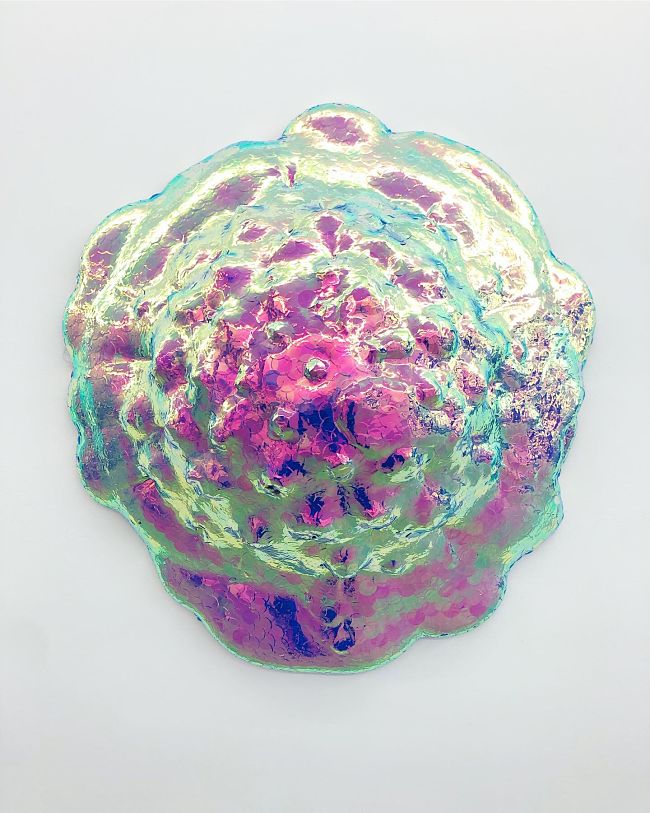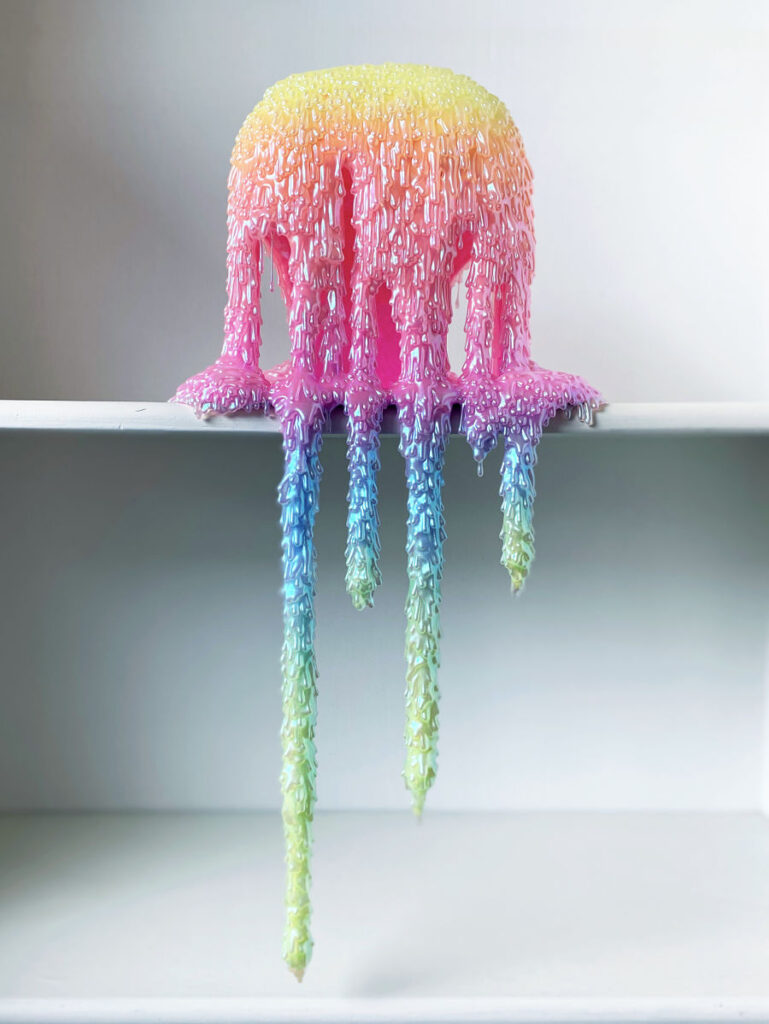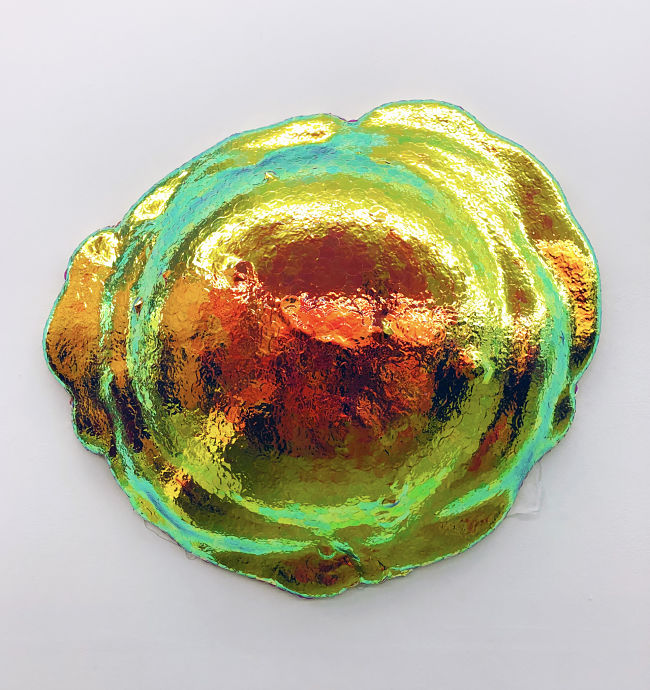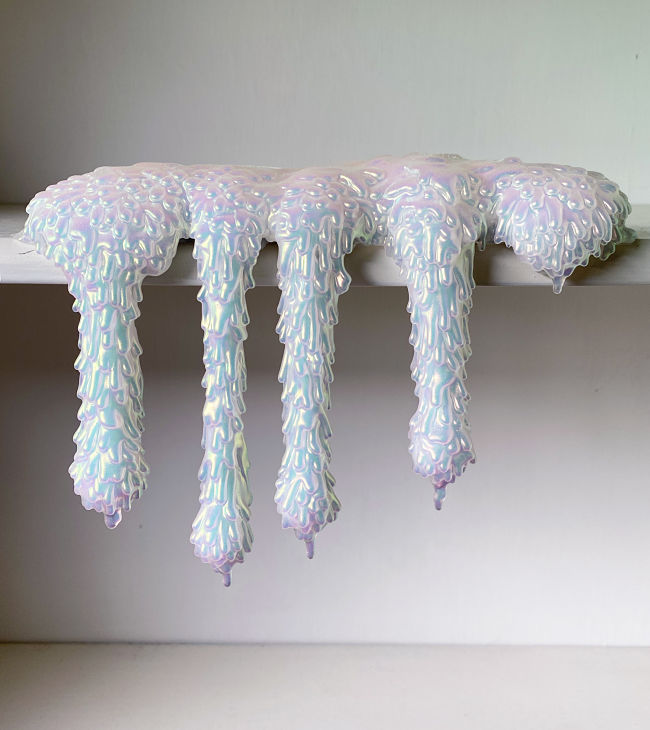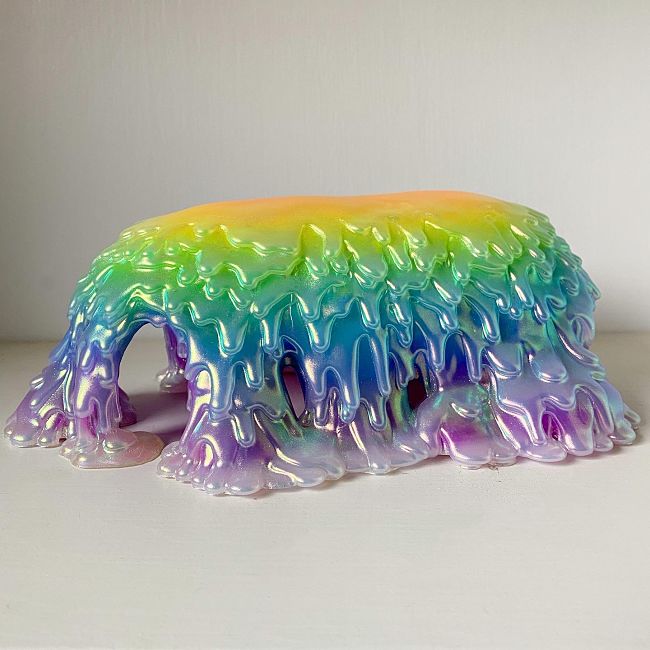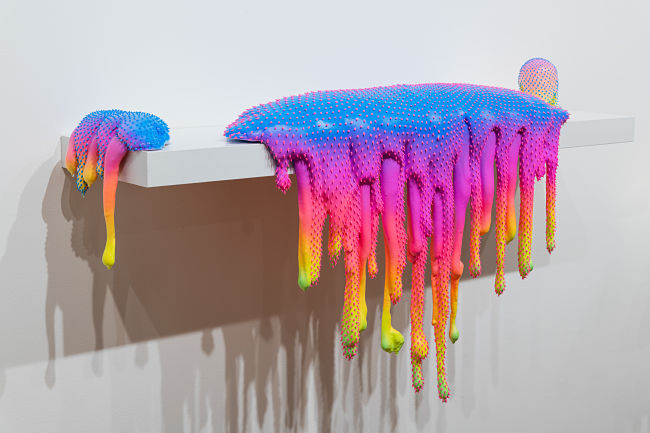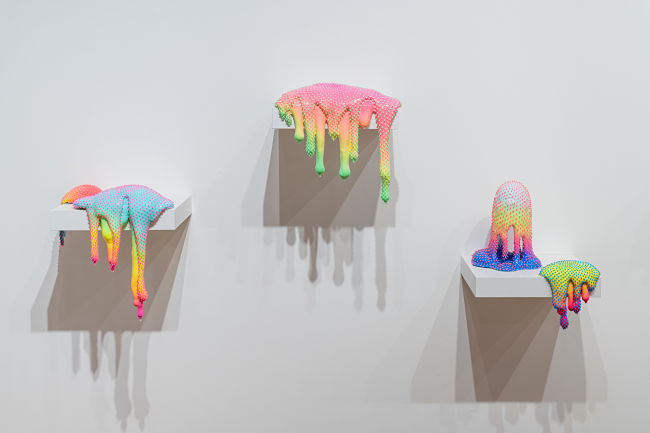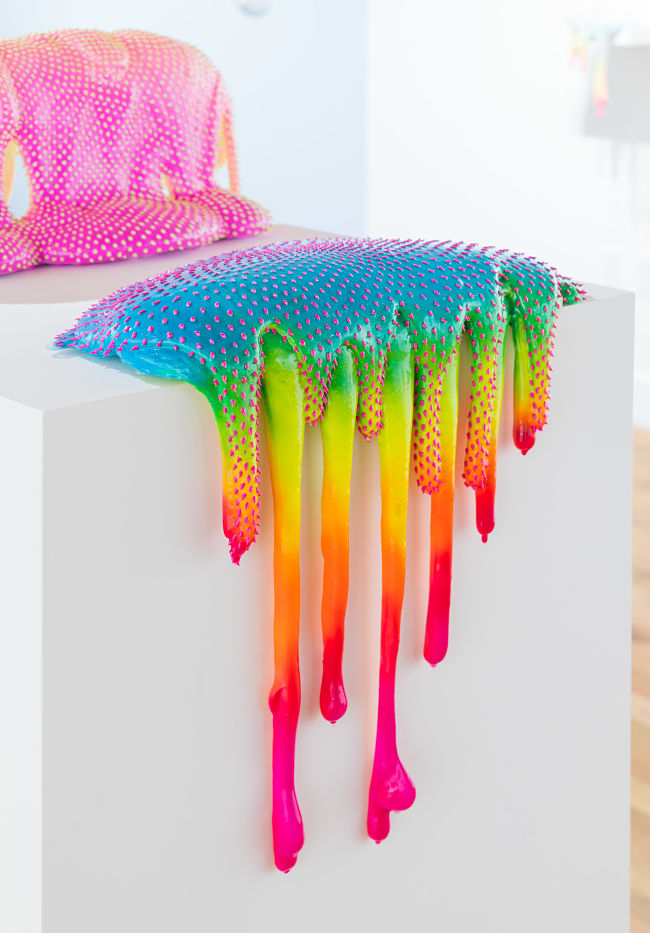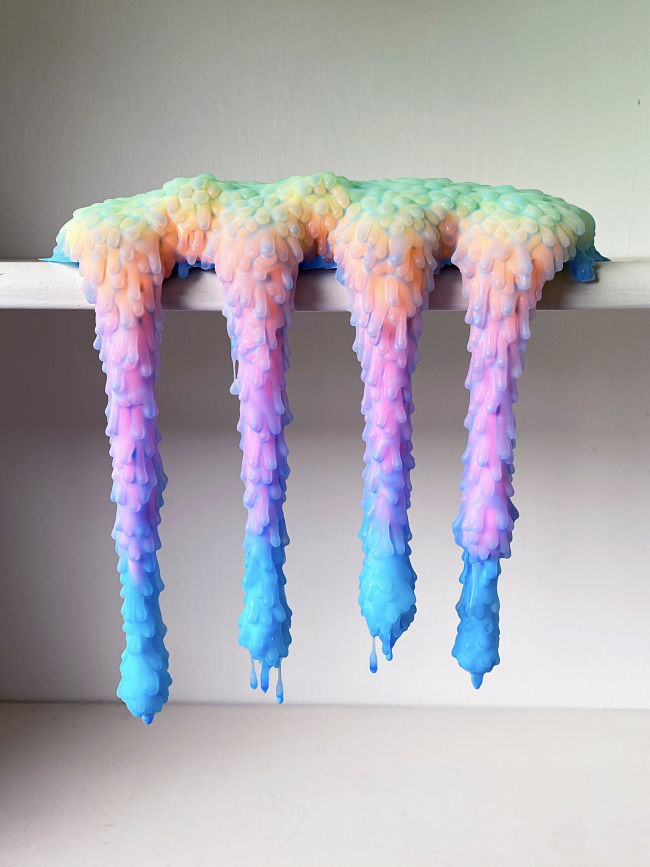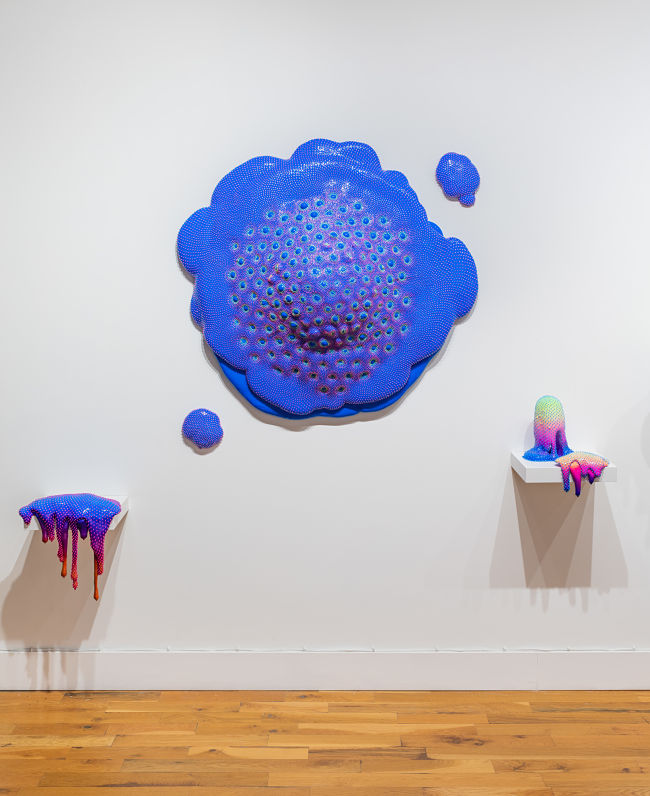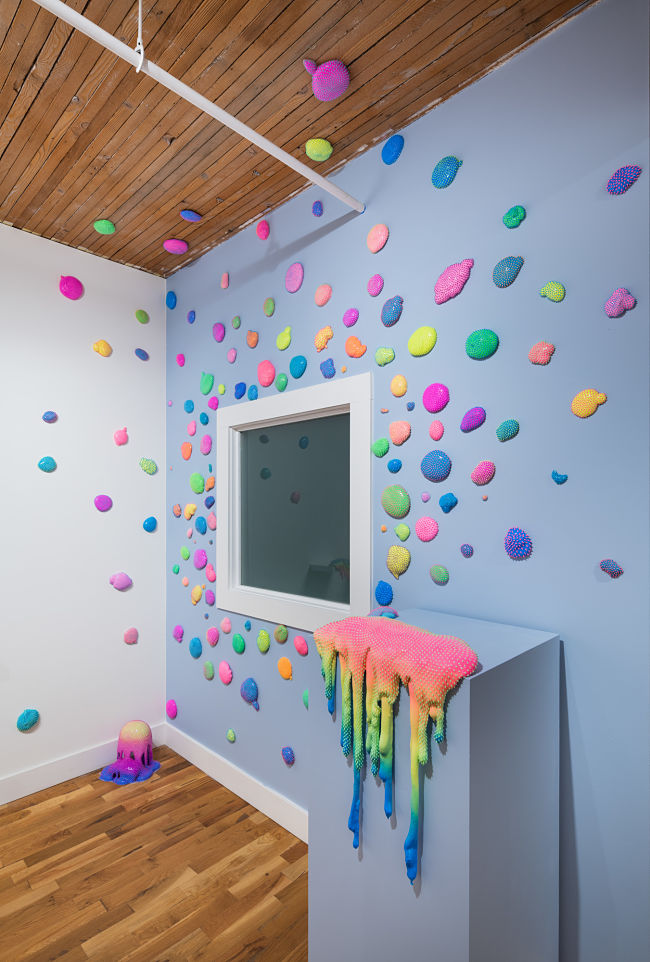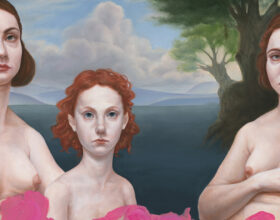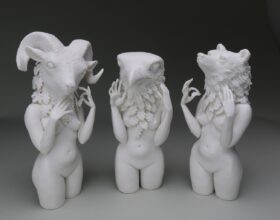Dan Lam is known for her incredibly colorful and whimsical sculptures. No two are alike and the pieces are as unique as the artist herself is. She is never afraid to experiment with textures, colors and finishes. Although some of her pieces look heavy in nature, they are quite light and I will eventually own one in the near future as it reminds me of her positively robust personality.
Her sculptural works add life to any area they are added to and so does she. And yes, for the longest time Dan Lam knows I thought she was a he as that didn’t bother her one bit.
I think there’s so much potential to delve into that space where opposing ideas meet, like beauty and disgust. I find that a lot of my ideas go there; for example, like creating organic forms with inorganic materials, the push and pull of implied softness vs the actual physical reality of a piece.
Dan, it was wonderful meeting you at Hashimoto Contemporary NY artist talk with dear friend and curator/gallery director Jennifer Rizzo. “Meet NYC” and the Schiller family always tap into such wonderful artists! That particular show, “Delicious Monster”, showcased quite a few pieces that were diversions from your usual neon and colorful palette. First I should ask you about your process as I learned that night you had only a matter of seconds to create your sculptures. Please tell our readers about how you form your pieces using the polyurethane foam and then how you take it from there to create each individual piece.
Polyurethane foam is a fun and challenging material to work with. I work with it because I love what it can do, the look it can create, and how it is not completely controllable. The sculptures are dependent on the surface they are made on. For example, with a drip sculpture, I need a pedestal or a 90-degree angle to pour on. The foam is quick and expands in a matter of 30 seconds, so my working time at this stage is short. I can guide where the foam goes and how much of it to pour, producing longer drips or thicker areas. Once that is fully cured, I start the process of layering resins and paints to achieve the look and colors I want. Adding texture is one of the final steps, it’s the most time-intensive and is a nice contrast to the quickness of the foam stage.
Also, as I mentioned, there were “dark” colored pieces. What was the impetus to create these pieces?
I was super interested in the material, which are black flat back beads treated with a sort of iridescent rainbow film. Beads can have a lot of association, especially with the world of craft. I wanted to push these in a way where you couldn’t immediately recognize what they were. When you see it from a distance you can’t really see the individual iridescence of each bead but it translates in an overall way. I also wanted to explore the textures the beads formed on top of my manipulated polyurethane foam surfaces.
Do you have any idea beforehand how your pieces will look? I wondered if you sketch or prepare before the foam actually hits the surface?
If it’s something totally new, I want to try; I’ll make a quick sketch to not forget about it. In general, I don’t sketch anything before working on a piece.
I believe the emotional theme behind the pieces is a juxtaposition between beauty and disgust? They are so tactile, usually bright in nature but have an almost eerie like look to them as they take on amorphic shapes. No matter how wonderful their coloring, they are a bit trippy and drippy looking. They seem to defy science in their one of a kind forms.
I think there’s so much potential to delve into that space where opposing ideas meet, like beauty and disgust. I find that a lot of my ideas go there; for example, like creating organic forms with inorganic materials, the push and pull of implied softness vs the actual physical reality of a piece. I think it’s fun to play in that space because it allows for a lot of exploration and leaves a lot of room for interpretation. It creates tension but also a sense of balance.
What relationship do you like to have with the audience as we cannot touch the pieces? Do you want us to desire to touch them but then feel angst when we cannot?! I know the only time I was able to touch your work was when you took over the coffee shop that was next to The Hole. I had a field day there as I always wanted to touch your work! A lot of children were squealing with delight and there I was a 50-year-old woman right alongside them doing the same thing.
I think that play with the audience goes back to the previous question. There’s definitely a desire that’s being created with the pieces, they are tactile and visceral, and there’s something about them that needs to be understood through touch. Take that and put a restraint on it, like not being able to touch because it’s art and it’s so interesting to witness. As my work has gone more into the world, I think about the viewer a lot more and what I want to happen when people look at my work.
Much like my materials, I’m not trying to dictate specifics or control the narrative; I want the interpretations and reactions to flow organically. But I also want to prompt those thoughts with my work. Ultimately, that sense of curiosity and discovery is the most I can ask for.
I think the juxtaposition comes into play with the spike textures and the clustering of the baby blobs (triggering in some people trypophobia) paired with those happy, candy colors.
Is there something you can share with me that you have not told another art journalist in any other interview before?
I get general questions about my education and my process but I want to let people know that the two aren’t mutually exclusive. I think when people hear I went to school for art, they assumed I learned about materials and techniques there. My classes were pretty traditional like figure painting, drawing, art history, and ceramics. And I’m glad I went to art school – I learned a lot there… like how to defend my work, how to be more articulate, how to critique. I learned about theory and concepts, and art history. But I learned about materials through just being curious and interested in figuring things out, and I explored them despite the focus of my degrees.
Your latest pieces on Instagram have a holographic sheen that I am completely obsessed with. I know we both share the love of the psychedelic look of these pieces. How did you create these colors? Is this a completely different color method for you to obtain?
Thank you! The effects you see are a mix and layering of base colors, interference pigments, and resin. The process for creating the colors is pretty different from the spiked pieces, but the foundation process is similar. I don’t want to say too much, at the moment, because I’m still figuring it out myself.
Due to the coronavirus, and its effect on all humans around the globe, most galleries have been forced to close, driving their work onto a new platform where possible- online sales and virtual openings. I believe your pieces at Stephanie Chefas Projects will be available online for purchase with $10 for every piece sold going to the Oregon Food Bank. How was that series different than the previous ones? I love that you created over 40 “baby blobs” that are physically smaller as it allows for a different price point. Have you done that before? I was scrolling and scrolling through all of the images and was excited by so many. This time I did not see the juxtaposition as much in this series as most appeared cheery like you!
I like the idea of art and art collecting to be obtainable by anyone who wants it. And I like to make pieces that are approachable for all types of collectors when I can. We also wanted to do something to help with the current situation and decided to donate some proceeds to the Oregon Food Bank, which is a local charity in Portland.
In the past, I’ve done mini versions of my drips, which have been released as individual pieces. With this show, the baby blobs were different in that they composed a larger installation. It’s a lovely idea to think that the collectors who buy a baby blob own something that is part of a larger thing. I think the juxtaposition comes into play with the spike textures and the clustering of the baby blobs (triggering in some people trypophobia) paired with those happy, candy colors. Of course, those feelings don’t happen for everyone and if they’re just beautiful and/or weird objects that’s cool too.
Is there a medium you would like to experiment with that you are intimidated by?
I can’t think of anything that I’m necessarily intimidated by. Enough time has passed in my practice that I have come to recognize some of my creative patterns. One of the things I tend to do is find new materials, play with it, collect it, and sometimes I put them to use right away or they sit there in my “toolbox” for months/years and one day there’s the perfect use for it. Silicone is one of those materials – I actually use it quite a bit behind the scenes but it hasn’t made a huge presence in the work itself.
Are there new collaborations you are working on that you can speak of?
I have a solo show coming up in September with Hashimoto Contemporary in San Francisco. There is also the potential for a new large public installation next year, but I can’t speak too much on that right now. It’d be a dream come true. Fingers crossed!
Dan Lam Social Media Accounts
Website | Facebook | Twitter | Instagram


